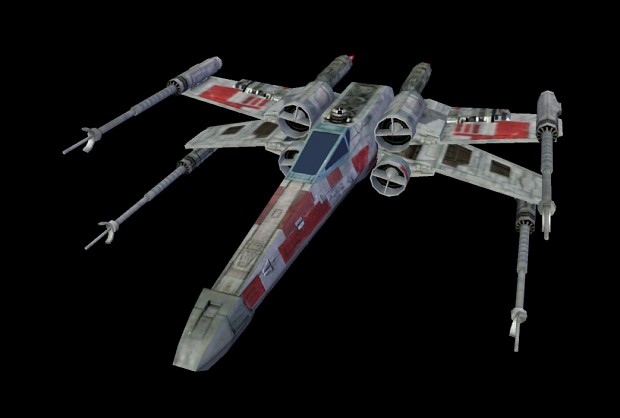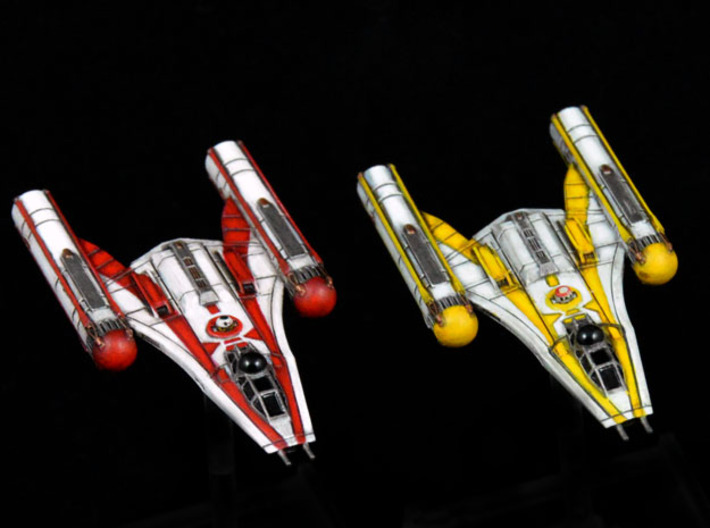
Armor plating was removed to save on weight and make it easier to perform maintenance, compensated for by increasing deflector shield power. Once acquired, Rebel technicians modified the fighter-bombers to make them more suitable to the Rebellion's hit-and-run tactics. Variants include the BTL-S3, which replaces the bubble turret with a remote-controlled turret and seats the gunner behind the pilot in the cockpit, and the BTL-A4, which removes the gunner altogether and gives the pilot control of the ion cannons. The module connects to two powerful ion engines via reinforced central spar and cross wing, all encased in heavy armor plating. The module contains the starfighter's armaments: two forward-firing laser cannons, twin ion cannons in the turret, and a pair of torpedo launchers with six-round magazines capable of launching bombs, cluster missiles and other ordnance. An astromech droid (which served as the fighter's navigation system) fits into a dedicated socket behind them. The original BTL-B Y-wing features a forward module seating a pilot in the cockpit and a gunner in a bubble turret. Rebel Y-wings were used to perform a variety of missions including courier, escort and reconnaissance. The Rebel Alliance sought to buy or commandeer as many Y-wings as possible and they became the most readily available starfighters to the Rebellion during the Galactic Civil War. However, when the war concluded and the Galactic Empire came to power, Y-wings were decommissioned and relegated to military surplus sellers or scrapyards. Prized for its durability and long-range striking capability, the success of the Y-wing prompted further production of the original model and a number of variants.

Y-wings would appear again during the climax of Star Wars: The Rise of Skywalker (2019).īased on Star Wars supplemental retail material, the Galactic Republic commissioned Koensayr Manufacturing to produce the BTL-B Y-wing during the early part of the Clone Wars. Here the Y-wings of Gold Squadron are shown playing a pivotal role during the Battle of Scarif in disabling an Imperial Star Destroyer with ion torpedoes.

Y-wings made their theatrical reappearance in Rogue One (2016), an anthology film set immediately prior to the events of the original Star Wars film. In the Star Wars Rebels 2014 animated series, the crew of the Ghost are shown stealing Old Republic Y-wings, in the process of being dismantled by the Galactic Empire, for use by the nascent Rebel Alliance. General Anakin Skywalker is shown leading a squadron of Y-wings on one of their first missions to take out a Separatist cruiser, where they are noted for their powerful shields and secondary gunner. Here they are depicted as fighter-bombers used by the Galactic Republic in the Clone Wars against the Separatists. Y-wings were later seen in The Clone Wars 2008 television series. (The pilot of the surviving Y-Wing differs between Canon and Legends) Y-wings made a brief appearance at the end of The Empire Strikes Back (1980) when the heroes are reunited with the Rebel fleet, and feature alongside other Rebel starfighters during the climatic space battle of Return of the Jedi (1983). Led by squadron leader Jon Vander ( Angus MacInnes), Y-wings made the first unsuccessful "trench run" on the Death Star's exhaust port, and only one Y-wing would survive the battle itself.
#Clone x wing movie
In the original Star Wars movie (1977), a group of Y-wings designated "Gold Squadron" took part in the attack on the Death Star. However, the dome did not appear properly when filmed against bluescreen and subsequent designs omitted the turret. Colin Cantwell, who also designed the saga's TIE fighters, initially designed the Y-wing with a large bubble turret for a gunner.


 0 kommentar(er)
0 kommentar(er)
